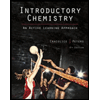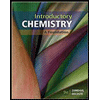
(a)
Interpretation: The classification of the given pair of compounds as constitutional isomers, stereoisomers, or not isomers is to be done.
Concept introduction: Isomers are the compounds with similar formula and different structures. Stereoisomers are a type of isomers in which arrangement of atoms differ in space. Or the compounds that have same molecular formula but they differ in the arrangement of atoms or groups in the space are known as stereoisomers.
Constitutional isomers are having the same molecular formula and different bond connectivity between the atoms.
(b)
Interpretation: The classification of the given pair of compounds as constitutional isomers, stereoisomers, or not isomers is to be done.
Concept introduction: Isomers are the compounds with similar formula and different structures. Stereoisomers are a type of isomers in which arrangement of atoms differ in space. Or the compounds that have same molecular formula but they differ in the arrangement of atoms or groups in the space are known as stereoisomers.
Constitutional isomers are having the same molecular formula and different bond connectivity between the atoms.
(c)
Interpretation: The classification of the given pair of compounds as constitutional isomers, stereoisomers, or not isomers is to be done.
Concept introduction: Isomers are the compounds with similar formula and different structures. Stereoisomers are a type of isomers in which arrangement of atoms differ in space. Or the compounds that have same molecular formula but they differ in the arrangement of atoms or groups in the space are known as stereoisomers.
Constitutional isomers are having the same molecular formula and different bond connectivity between the atoms.
(d)
Interpretation: The classification of the given pair of compounds as constitutional isomers, stereoisomers, or not isomers is to be done.
Concept introduction: Isomers are the compounds with similar formula and different structures. Stereoisomers are a type of isomers in which arrangement of atoms differ in space. Or the compounds that have same molecular formula but they differ in the arrangement of atoms or groups in the space are known as stereoisomers.
Constitutional isomers are having the same molecular formula and different bond connectivity between the atoms.
Want to see the full answer?
Check out a sample textbook solution
Chapter 5 Solutions
Organic Chemistry (6th Edition)
- Predict the hydrocarbon, of formula C6H10, needed to prepare the following geminal dibromide upon treatment with excess hydrobromic acid. Note: The shown product is the only regioisomer formed in this reaction. HBr H₂C. CH3arrow_forwarddraw the major product formed with the listed reagentsarrow_forwardPropose Williamson ether syntheses for the following compoundsarrow_forward
- Identify all functional groupsarrow_forwardA mixture of CaCO3 and MgC2O4 of unknown mass was heated in a 0.5 L closed rigid vessel to 900 degrees C.at 400C the following reaction occurs:MgC2O4 -> MgO (s) + CO (g) + CO2 (g)At 700C a second reaction occurs: CaCO3 -> CaO (s) + CO2 (g)The solid mass in the vessel was measured to be 3.06 g at 400C and 2.03g at 900CQuestion: What is the partial pressure of CO in both temperatures? (400 and 900C), provide detailed explanation.arrow_forwardFor the following alkyne, complete the reaction sequentially (that is draw the intermediate that we can’t stop at) and then name (complete name) all 3 molecules.arrow_forward
- Given the reaction sequence below, answer the following. A. Provide the structure for A. B. Provide the structure for B (pay attention to stereochemistry). C. Provide the structure for C. D. What are the stereochemical designations for I and II (R/S)?arrow_forwardWhich of the following is the most stable carbon radical?arrow_forwardPut the following carbon radicals in order of increasing stability.arrow_forward
- Draw the major organic product for each of the following reactions (pay attention to stereochemistry).arrow_forwardThere are 2 reactions (that you know of) to achieve the following transformation: One reaction is favored over the other because it avoids a competing reaction. A. Draw the favored reaction scheme (not the mechanism), be sure to include all necessary reagents. B. Draw the reaction scheme that is not favored and include all the possible products.arrow_forwardBoth carbocations and carbon-radicals have trigonal planar geometry. True or Falsearrow_forward
 Introductory Chemistry: An Active Learning Approa...ChemistryISBN:9781305079250Author:Mark S. Cracolice, Ed PetersPublisher:Cengage Learning
Introductory Chemistry: An Active Learning Approa...ChemistryISBN:9781305079250Author:Mark S. Cracolice, Ed PetersPublisher:Cengage Learning Chemistry for Today: General, Organic, and Bioche...ChemistryISBN:9781305960060Author:Spencer L. Seager, Michael R. Slabaugh, Maren S. HansenPublisher:Cengage Learning
Chemistry for Today: General, Organic, and Bioche...ChemistryISBN:9781305960060Author:Spencer L. Seager, Michael R. Slabaugh, Maren S. HansenPublisher:Cengage Learning Introductory Chemistry: A FoundationChemistryISBN:9781337399425Author:Steven S. Zumdahl, Donald J. DeCostePublisher:Cengage Learning
Introductory Chemistry: A FoundationChemistryISBN:9781337399425Author:Steven S. Zumdahl, Donald J. DeCostePublisher:Cengage Learning World of Chemistry, 3rd editionChemistryISBN:9781133109655Author:Steven S. Zumdahl, Susan L. Zumdahl, Donald J. DeCostePublisher:Brooks / Cole / Cengage Learning
World of Chemistry, 3rd editionChemistryISBN:9781133109655Author:Steven S. Zumdahl, Susan L. Zumdahl, Donald J. DeCostePublisher:Brooks / Cole / Cengage Learning



